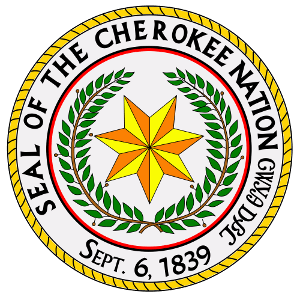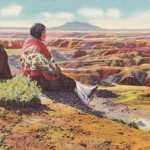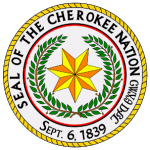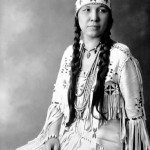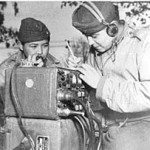Cherokee Heritage Center ~ Tahlequah, Oklahoma
In 1838, approximately 16,000 Cherokee people were driven from their homes and forced to move west into Indian Territory. This tragic exodus became known as the Trail of Tears. For many of those weary travelers, Tahlequah, Oklahoma, was the end of that trail.
But the story does not end with the arrival of the Cherokee people in Oklahoma. Despite this tragic event, they built successful communities that exist today. In an attempt to preserve the history and culture of the Cherokee, the Cherokee National Historical Society Inc. was established in 1963. The Society fulfills this mission by operating the Cherokee Heritage Center on 44 wooded acres.
Rich in culture, the Cherokee Heritage Center offers many activities and events designed to educate the public about Cherokee culture. Designed by Charles “Chief” Boyd, a Cherokee architect from Tulsa, as his master’s thesis, the Heritage Center is home to many historical effects.
In front of the museum are three large columns. These columns are the remains of the Cherokee National Female Seminary that was built in 1851. It was the first school of higher education for women west of the Mississippi River, and the first to pay equal salaries to male and female instructors. The school burned on Easter Sunday, 1887. It was rebuilt on the north side of Tahlequah and reopened in 1889 and was the forerunner of Northeastern State University. The rebuilt seminary is today known as Seminary Hall.
The Cherokee National Male Seminary was located on the south side of Tahlequah at the present site of Markhoma Bible Academy. It burned in 1912.
Located near the columns entrance of the Cherokee Heritage Center National Museum is a large rock with a hole in it. This rock is the cistern cover from the female seminary. Next to the rock is a depressed area. This area is the site of the actual cistern. The ground there settled years ago. It was leveled off only to settle again.
Also in front of the museum are many statues, busts and monuments, each holding special meaning. A marble cube stands in memory of Robert L. Owen, one of Oklahoma’s first two U.S. Senators. He was a member of the Cherokee Nation and is known for drafting the legislation that created the Federal Reserve System.
The statue of a runner honors Andy Payne, a poor farm boy from Foyil, Oklahoma. About to lose the farm, Payne heard of a cross-country race that paid $25,000 to the winner. He hitch-hiked to Los Angeles and competed against the greatest track stars of that day. He won the race, saved the farm, converted his fame into a political career and served as clerk of the Oklahoma Supreme Court for many years.
The column in front of the Gathering Place contains the names of several people important to Cherokee history. This column includes names of the detachment conductors on the Trail of Tears, judges, sheriffs and other notable persons.
Three busts are located with the other statues and monuments. One of these is of Elias Boudinot. Boudinot was the editor of the Cherokee Phoenix in 1828, the first newspaper to be printed in a native language. Boudinot, his brother Stand Watie, John Ridge and Major Ridge led the group that signed the Treaty of New Echota in 1835. He was assassinated in June of 1839 for his role in signing the Removal Treaty. Boudinot is buried two miles from the Cherokee Heritage Center at Worcester Cemetery.
Another bust is that of John Ross. Ross served as Chief of the Cherokee Nation longer than any other elected chief. He became chief in 1827 and served until his death in 1866. Ross is buried about two miles from the Cherokee Heritage Center at Ross Cemetery.
The third bust is that of Adm. Joseph J. “Jocco” Clark. He is a Cherokee from Chelsea, Oklahoma, and is one of the highest ranking American military figures in history. Clark was a pioneer of naval aviation and began World War II as Captain of the aircraft carrier Saratoga. During the Korean Conflict, he was Admiral of the 7th Fleet. Clark was also one of the early board members of the Cherokee National Historical Society.
Behind the museum are small buildings making up Adams Corner Rural Village. This village contains seven buildings designed to represent lifestyle as it might have been found in the Cherokee Nation between 1890-1900, just before Oklahoma statehood.
In addition to the buildings in Adams Corner, there are a number of animals that were typical of Cherokee settlements such as Dominique Chickens, Pineywood Cattle, and Cherokee Ponies.
The Cherokee Heritage Center is also home to the Tsa La Gi Amphitheater. This 1,800 seat amphitheater comes to life every summer with theater and dance as the “Trail of Tears Drama” unfolds. The amphitheater is recognized as one of America’s most beautiful outdoor theater venues.
Located near the Tsa La Gi Amphitheater on the Cherokee Heritage Center grounds is a small round building. This building is the Ho-Chee-Nee Trail of Tears Memorial Prayer Chapel. Jimalee Burton, a poet and an artist, funded the chapel in 1978 as a memorial to the Trail of Tears and a place for people to meditate. Inside you will find elements of both Cherokee and Christian traditions. For example, there are seven poles supporting the roof to represent the seven clans. They are supported at the top by three vertical poles representing the Holy Trinity, Father, Son and Holy Ghost.
Located on the corner of the museum is a Masonic cornerstone. The Masons played a large role in the Cherokee Nation. Cherokees established the first Masonic lodge in Tahlequah in 1848. It met in the Supreme Court building, which still stands downtown. This Masonic cornerstone is very unusual. It should be located in the northeast corner, this one is in the southwest corner. It should be square, this one is trapezoid. It should be level, this one is lower on the right side than the left. It should be plumb, this one is set on an angled wall.
In addition to the Cherokee Heritage Center, Tahlequah is home to other historical sights such as the Cherokee National Capital Building, the Supreme Court Building and the Cherokee National Prison.

